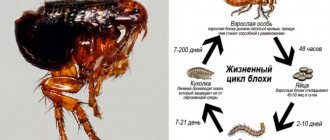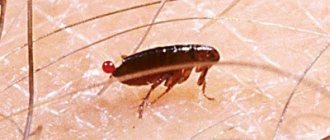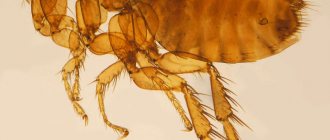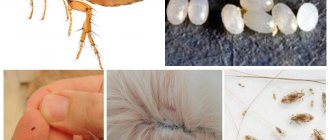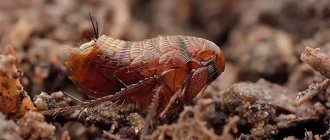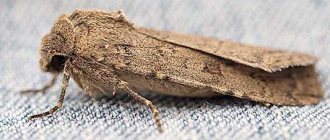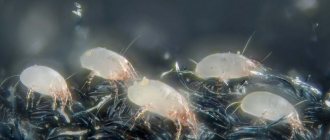Fleas belong to the order of blood-sucking insects. They can be called carriers of pathogens of various diseases that pose a danger to humans and animals.
Wingless insects have a highly specialized oral apparatus necessary for puncturing the skin of the victim and further sucking blood.
Being small in size, parasites are capable of jumping long distances. They often enter houses through basements, entrances, small cracks, and microcracks . Sometimes they can be found even in apartments where there are no pets. If the owner promptly discovered that his pet was suffering from parasites and removed them using special means, flea eggs may still remain in the house, which, under favorable conditions, subsequently become adults capable of leaving offspring.
What do flea larvae look like?
Often, many people, faced with the problem of removing fleas, are interested in what a flea egg looks like? In fact, since both humans and animals can be carriers of parasites, there are some differences that are very difficult to determine without special knowledge.
If we consider the color of a cat or dog flea egg, its shape and size, we can highlight the following features:
- oval shape;
- miniature size (up to 1 mm);
- White color.
The larvae of bloodsuckers that infect animals resemble tiny translucent worms that, after hatching from the egg, remain there until full maturity.
Anabiosis is possible because they do not require blood as food in this state.
Under a microscope, you can see that the entire body of the larva is covered with small hairs; there are no legs. Since the body is translucent and whitish in color, the esophagus with food digesting in it is clearly visible. The larva has a large head for its size with powerful jaws. This feature allows the larva to feed on the toughest food that it comes across.
Do fleas fly or not, do they have wings?
Many people who have seen how quickly and far fleas move in space have a logical question: can these insects fly.
The structural features of the insect are such that it does not have wings. But the long hind legs and the dense shield on the front of the body made of protein matter deserve special attention.
The locomotor system of the parasite is designed like a tiny catapult: when the legs are bent, the shield is pulled back, and when unbent, the flea seems to shoot into the air. The remaining two pairs of legs help the parasite when jumping and landing. In a calm state, the insect collects its limbs in the shape of an accordion so as not to interfere with feeding.
Even the very shape of the bloodsucker’s body – flattened on the sides – gives the parasite ergonomics and additional advantages when moving.
The body length of the blood-sucking insect is no more than 2–3 mm, but the flea jumps over distances up to 100 times greater. In one jump, the pest covers 20 cm in length and up to 35 cm in height.
Thus, fleas do not fly, but they jump high and far, which is why it often seems to a person that the insect moves exclusively in flight.
How do they reproduce?
Despite the fact that fleas reproduce quickly, the process itself is quite complex and requires maintaining certain favorable conditions. The male has testes (2 pieces), ending with genital claws, through which the seed is transmitted to the female. The female has 2 or 4 ovaries, oviducts connecting at the body of the uterus, containing the spermatheca, located at the end of the abdomen in the form of a curved tube.
At the moment of mating, the female climbs onto the male’s back, after which she sucks up the sexually mature organ with the spermatheca. From the testes of a male to the body of a female flea, the seed travels on average about 10–15 minutes. While mating itself can last about a day.
After fertilization, the flea lays eggs in batches (4 to 10 pieces). Since the female needs strength for this, she must be satisfied with food before laying eggs. With normal saturation, a blood-sucking female is capable of laying eggs several times a day.
However, more often females lay one portion per day. Over the entire life cycle of a flea, it is capable of laying 500 eggs, which often infect a pet.
Due to the fact that insects place future offspring on the carrier in advance, subsequently the larvae can easily get enough food and grow quickly. In addition to animal fur, fleas leave clutches in places where they frequent.
The laying process is unique - the female throws eggs from her abdomen over a long distance. It is this method that ensures the vitality of the offspring, since they are at a distance and can eat normally without creating competition for each other.
Insect habitats
Fleas do not live on the animal itself. Insects prefer to settle next to a potential breadwinner: in caves, nests and burrows of animals and birds. This is necessary in order to have free access to food and drink blood at any time.
It is much easier for insects to survive in an apartment or residential building. Their habitats may be:
- bedding and resting places for pets (houses, mattresses, baskets),
- floor cracks, baseboards and carpets,
- bed sheets,
- deposits of clothes,
- furniture, bed mattresses,
- storage areas for vegetables or garbage.
The eggs fall to the floor directly from the animal, so they can end up anywhere, but the most common habitats are those that are closer to the owner - the bed and carpets.
Where to look for them
Maturing individuals can be found not only in the fur of animals, but also in various places in the room or apartment where they live. They can be found in corners, crevices, microcracks in floors, behind baseboards, under wallpaper.
Formed bloodsuckers can settle in warm blankets, under the upholstery of upholstered furniture, and inside pillows. Since these insects are blood-sucking, feeding exclusively on blood, their habitat is limited to areas where a person or animal is often found. Thanks to this, they can always find food to survive.
The most likely habitats in which fleas live without an animal in an apartment are:
- sleeping places for pets;
- cracks behind the baseboards, in the floor;
- carpets, upholstered furniture, pile of toys;
- places with high humidity levels (under the bathtub, sink, shower).
Since the female parasite shoots her eggs in different directions when laying eggs, they can colonize any surface. And since the bedding of cats and dogs contains everything necessary for the full development of flea larvae, in addition to the animal’s fur, the flea larva feels comfortable in a sleeping place.
Adults
The parasites that most insecticides target are adult fleas. An adult insect can reach up to 5 millimeters in size, has a black (these are young fleas) or brown color, and is covered with scales. In the animal's fur, the pest is somewhat reminiscent of a small grain of a plant.
The main difference between fleas and other insects: pests can jump up to thirty centimeters in length, escaping from danger or moving from victim to victim. Sometimes these jumps can be seen with the naked eye. Fleas differ from bed lice in their large size, and from bedbugs in their ability to jump.
Lifestyle and nutrition of future parasites
Flea larvae are not parasites, since they feed on decaying organic compounds, which make up particles of dead plants, excrement of formed fleas, containing undigested crusts of the victim's blood.
The larvae themselves do not feed on blood, therefore in this state they are harmless to humans and animals.
Maturation of the larvae lasts from 2 to 14 days. After this, the eggs hatch and small parasites continue to develop. The period of final maturation depends on environmental conditions; the more comfortable the larva feels, the faster the process of formation of the individual occurs.
If the ambient temperature is warm enough and there is a high level of humidity, the larvae will develop into an adult within a couple of days. An underdeveloped individual feeds on the feces of mature individuals, dried blood crust, and other layers of organic matter.
As the larva grows, it molts (3 times), after which it pupates like a butterfly. The time the larva remains in the cocoon ranges from several weeks to several months. It depends on the environmental conditions.
If they are unfavorable, the cocoon can remain unchanged for a year until the victim is in close proximity. According to scientists, even in the pupal state, a flea can smell blood. After emerging from the cocoon, the final stage of insect development begins.
Lifespan of fleas
The average lifespan of a parasite is 3–4 months. But everything depends on external conditions:
- air humidity,
- air temperature,
- availability of food.
If fleas are infested in an apartment where there is no control over them or pets, the lifespan is not reduced. In the absence of animals, fleas do not disdain human blood, even if they are representatives of the dog and cat families. In addition, parasitism on dogs and cats, on the contrary, is more dangerous for them - animals have instinctive cleanliness and kill parasites by gnawing with their fangs and combing.
Fleas can live without food for 4–5 months. They do not slow down their development, but they stop producing offspring. However, cat fleas are known for discarding insects that starve to death within 12 hours (males) and 96 hours (females).
The survival rate of insects also depends on a number of accidents:
- according to statistics, less than half of the eggs laid by one insect survive the full cycle of transformation,
- some eggs and adult insects can be eaten by the breadwinner,
- Eggs are laid at any time of the day and at any moment. Therefore, they can find themselves either indoors and warm, or on a cold frosty street where it is impossible to survive. If the eggs end up in a place where the future larva has nothing to feed on and a lot of sunlight, then the insect also has no chance of surviving.
Are they dangerous for humans?
Fleas and their larvae can be carriers of various serious diseases that pose a threat to human life:
- Bubonic plague;
- encephalitis;
- anthrax;
- trypanosomiasis;
- tularemia;
- typhus and relapsing fever, etc.
The likelihood of a threat may not be the norm, but a certain percentage remains. This is the most terrible threat to human health and life.
In addition, if you eat food without washing the eggs with your bare hands, you can become infected with various types of worms.
Appearance of the larvae
Flea larvae
What flea larvae look like depends on the stage of development. Initially they are born as white, translucent worms. Length does not exceed 1 mm. Their food consists of feces of adults, skin remains, and rot. They begin to eat actively.
Over time, worms accumulate in places where they can find food:
- dog bedding, cat mats;
- trash bins;
- baskets for storing vegetables, flower pots;
- pet toilet, feeders.
A week later, the first molt occurs. Flea larvae increase in size, but do not change appearance. The worms are already more like a caterpillar. The contents of the esophagus are visible through the transparent body. The color becomes dirty gray. During the entire developmental stage, the flea molts three times. Increases to 4 mm.
At the last stage of flea development, pupation occurs. The larva envelops itself in a cocoon and stops moving. Already after 2 days it emerges from there as an adult.
On a note!
Flea larvae do not live on cats' bodies. You should look for them near the sleeping place, near the toilet. Check all the places where your pet likes to relax and spends a lot of time. Dogs also develop fleas. Animals are not even the host for these parasites. Development occurs outside the body.
How to get rid of pests
Many, faced with this problem, wonder how to get rid of flea larvae? The first need when detecting insects on your beloved pet is to thoroughly clean the apartment.
The use of insecticidal drops and a flea collar for animals is not enough, since the laid eggs of parasites can remain in a state of suspended animation for a long time, and are activated when favorable conditions for life occur.
Treatment of premises against fleas and their eggs consists of several stages:
- carrying out general cleaning to get rid of eggs and parasite larvae as much as possible;
- spraying chemicals on furniture moved to the center and overturned, carpets infested with flea larvae. The most popular include Executioner, Cucarachi, Tetrix, Raptor, Combat;
- sealing the room for several hours (pets should also not be in the apartment during this entire time).
After the treatment has been carried out, it is necessary to ventilate the room well, beat the carpets outside, then vacuum them. In the warm season, some resort to airing and drying furniture, exposing it outside to the scorching rays of the sun.
This is explained by the fact that fleas and their larvae die at high temperatures. Therefore, in addition to chemical reagents, it is necessary to treat premises with high temperatures.
Methods for killing parasites
Although the larvae do not pose a danger to people and animals, they are exterminated, as they later turn into aggressive insects.
Not all drugs that are used to kill adult insects can rid an apartment of their offspring. Aerosols quickly cease to be effective after application and are therefore of little use for combating larvae.
To exterminate them, they use species equipped with attachments to penetrate hard-to-reach places. Strong-smelling plants such as wormwood repel adult fleas but have no effect on larvae.
Insecticidal flea dusts work flawlessly. They mix with the food that the parasites eat and enter the body, causing them to die. But with their help it is difficult to exterminate the larvae that have bred under the floor. Microencapsulated preparations Get, concentrated preparations Tetrix, Karbofos, Cucaracha are also suitable for killing parasites.
Prevention measures
Sometimes the appearance of fleas is purely an accident. Such sources cannot be excluded in any way, but the chances of parasite penetration can be reduced. And here, banal household hygiene remains an effective preventive measure - regular wet cleaning, beating carpets, airing. It is especially important to avoid clutter and neglect. After all, in a clean and well-kept home, even a flea that suddenly appears will not stay long.
If your family has pets, carefully monitor their health, bathe and brush them regularly. For pets that often visit the street, purchase anti-flea collars and use insecticidal shampoos in their care. It is important to promptly treat already infected four-legged animals.
Fleas have inhabited our planet for many millions of years. There’s definitely no point in doubting their evolutionary progress, just as there’s no point in downplaying the anxiety from their neighborhood. Hardy, invulnerable and fast insects will not easily retreat from the occupied territory. Therefore, when you first detect an enemy, do not wait for the colony to grow, but immediately begin to fight.
Where do earth fleas live?
You can determine the main place where earthen fleas live by the name of the species. What brings them to human habitation is the desire to taste human blood. Adult ectoparasites prefer to settle in garages, basements and outbuildings where there is a lot of earth or sand. They feel comfortable in crevices, corners and other secluded places.
Ground fleas do not live in apartments and houses near humans all the time. They come here only in search of another victim through numerous cracks in the walls and flooring. When they have drunk enough blood, the individuals leave the house and return to the basement or other outbuilding. It is not for nothing that they choose these places for permanent residence. Utility pipes (water supply, sewerage and heating) run in the basement. They provide a microclimate with optimal temperature and humidity, which adults need for reproduction. An additional advantage of the technical room is unsanitary conditions due to infrequent cleaning.
Pet hair
Among those that cause us the most trouble are dog, cat, rat and human fleas. Despite their distinctive names, these species can feed on the blood of any warm-blooded animal, including humans.
Animal fur is obviously the most preferred habitat for a flea. But how much time she spends there is influenced by species and age. Adult fleas spend 50 to 90% of their time on their host. They use strong limbs to grab onto the animal's fur and settle there. The food source is thus always nearby. After all, without regular feeding, female fleas will not be able to lay eggs.
If you try to catch a flea on a pet, it will use all its abilities to dodge and stay on its host.
How to get rid of fleas on pets
If fleas live only on a pet, you can get rid of them simply by treating the animal with a special remedy - tablets, anti-flea shampoos, collars, drops, etc. However, it may happen that this will only kill the adult fleas, while individuals from other stages of the flea life cycle that are outside the animal's fur will survive.
Types, photos and names
Zoologists have identified up to 27 families of fleas; we will describe the most interesting of them.
human flea
It is the most common among fleas and lives everywhere. It is brown in color and 1.6-3.2 mm long. Moreover, this flea is capable of jumping to a height of up to 30 cm and half a meter in length. Unlike other fleas, it does not have thoracic or head teeth. It can parasitize various animals, including humans (hence its name). In addition to humans, it is often found in animals that have close contact with humans: primarily in cats, dogs and
horses. It is very dangerous, as it can carry the plague pathogen and cause pulicolosis - an itchy skin lesion.
Cat flea
Despite the name, this flea lives not only on cats, but also on dogs, rodents, and many other animals, sometimes even on humans. The cat flea has a short proboscis and a flat forehead, the body length is 0.75-5 mm.
Dog flea
This flea is a close relative of the cat flea, and can also live on dogs, cats and other animals, including humans. In appearance and size it is similar to a cat flea, the only difference is in life expectancy, if a cat flea lives up to 2 years, then a dog flea lives no more than 1.5 years.
Southern rat flea
This type of flea is especially dangerous because it carries plague, mouse and rat tapeworms. It lives everywhere, but to a large extent these fleas are common in areas with warm tropical climates. Females range from 1.8 to 2.7 mm in length, males are slightly smaller: 1.4 to 2 mm. They may be light or dark brown in color. Most often they parasitize rats and other rodents, living in their burrows or nearby.
Penetrating flea
She is also the sand flea or the Brazilian ground flea. Originally from Brazil and Haiti, this flea was eventually introduced to Africa, India and Pakistan, where it successfully took root. It has an oval-shaped body and a red-brown color with a white spot in the middle. The average body length of this flea species is 1 mm, and it is capable of jumping to heights of up to 30 mm. Usually lives in the grass, from where it jumps on animals, birds and humans. Penetrates under the skin of animals' feet. A person can penetrate under the nails of his toes and fingers, and lead to inflammation, tetanus, and in especially difficult cases, gangrene and amputation of limbs.
Signs of fleas in your home
Let's figure out how to determine that there are parasites in the house. First of all, these are bites. Flea activity manifests itself on the legs - from the feet to the lower legs. Further than 20-30 cm, that is, the height of the insect's jump, inflammation does not spread.
Recognizing flea bites is not difficult. These are hard bumps with a tiny hole in the center and redness around the perimeter. During feeding, one individual makes peculiar paths, leaving 3-5 bites at a distance of 0.5-1 cm. Subsequently, the problem area swells, itches, and in severe cases, ulcers form.
You should also examine your pets by parting the fur and exposing the skin. If numerous black dots (insect feces) are visible on the hair and body, then you can be sure that flea eggs and larvae are already developing in secluded places in the apartment.
For reference ! An easy way to find out if there are pests in your home is with a blank sheet of paper. We place several pieces in places where the pest is expected to be concentrated and wait about half an hour. Small dark dots are clearly visible on contrasting paper.


